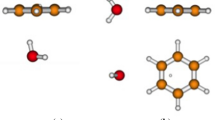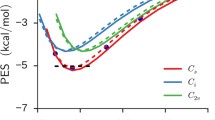Abstract
The structure of liquid benzene is investigated by quantum molecular dynamics simulations. Results using variationally optimized numerical pseudo-atomic orbitals are compared to those of generic optimized orbitals. The accuracy of the first-principle calculations is compared with recent experimental findings. Simulations using minimal basis sets with optimized orbitals are shown to successfully predict the local structure of liquid benzene, while simulations with non-optimized minimal basis sets have significant errors in the structure of the first solvation shell. The use of a minimal optimized basis set considerably speeds up simulations, while preserving much of the accuracy of a larger basis set formed by generic orbitals. The transferability of the optimized orbitals is also explored under different environmental conditions.






Similar content being viewed by others
References
Vallee R et al (2000) Nonlinear optical properties and crystalline orientation of 2-methyl-4-nitroaniline layers grown on nanostructured poly(tetrafluoroethylene) substrates. J Am Chem Soc 122(28):6701–6709
Meyer EA, Castellano RK, Diederich F (2003) Interactions with aromatic rings in chemical and biological recognition. Angew Chem Int Ed 42(11):1210–1250
Baker CM, Grant GH (2007) Role of aromatic amino acids in protein–nucleic acid recognition. Biopolymers 85(5–6):456–470
Hunter CA (1993) Aromatic interactions in proteins, DNA and synthetic receptors. Philos Trans R Soc Mathe Phys Eng Sci 345(1674):77–85
Cox EG, Smith JAS (1954) Crystal structure of benzene at-3-degrees-C. Nature 173(4393):75
Cox EG, Cruickshank DWJ, Smith JAS (1955) Crystal structure of benzene—new type of systematic error in precision X-ray crystal analysis. Nature 175(4461):766
Cox EG, Cruickshank DWJ, Smith JAS (1958) The crystal structure of benzene at-3-degrees-C. Proc R Soc Lond Ser Mathe Phys Sci 247(1248):1–21
Janda KC et al (1975) Benzene dimer—polar molecule. J Chem Phys 63(4):1419–1421
Steed JM, Dixon TA, Klemperer W (1979) Molecular-beam studies of benzene dimer, hexafluorobenzene dimer and benzene–hexafluorobenzene. J Chem Phys 70(11):4940–4946
Hopkins JB, Powers DE, Smalley RE (1981) Mass-selective 2-color photo-ionization of benzene clusters. J Phys Chem 85(25):3739–3742
Langridgesmith PRR et al (1981) Ultraviolet-spectra of benzene clusters. J Phys Chem 85(25):3742–3746
Venturo VA, Felker PM (1993) Intermolecular Raman bands in the ground-state of benzene dimer. J Chem Phys 99(1):748–751
Hobza P, Selzle HL, Schlag EW (1996) Potential energy surface for the benzene dimer. Results of ab initio CCSD(T) calculations show two nearly isoenergetic structures: T-shaped and parallel-displaced. J Phys Chem 100(48):18790–18794
Sato T, Tsuneda T, Hirao K (2005) A density-functional study on pi-aromatic interaction: benzene dimer and naphthalene dimer. J Chem Phys 123(10):104307
Sinnokrot MO, Sherrill CD (2006) High-accuracy quantum mechanical studies of pi–pi interactions in benzene dimers. J Phys Chem A 110(37):10656–10668
van der Avoird A et al (2010) Vibration–rotation–tunneling states of the benzene dimer: an ab initio study. Phys Chem Chem Phys 12(29):8219–8240
Henson BF et al (1992) Raman-vibronic double-resonance spectroscopy of benzene dimer isotopomers. J Chem Phys 97(4):2189–2208
Erlekam U et al (2006) An experimental value for the B-1u C–H stretch mode in benzene. J Chem Phys 124(17):171101
Tsuzuki S et al (2005) Ab initio calculations of structures and interaction energies of toluene dimers including CCSD(T) level electron correlation correction. J Chem Phys 122(14):144323
Lowden LJ, Chandler D (1974) Theory of intermolecular pair correlations for molecular liquids—applications to liquids carbon-tetrachloride, carbon-disulfide, carbon diselenide, and benzene. J Chem Phys 61(12):5228–5241
Narten AH (1968) Diffraction pattern and structure of liquid benzene. J Chem Phys 48(4):1630–1634
Narten AH (1977) X-ray-diffraction pattern and models of liquid benzene. J Chem Phys 67(5):2102–2108
Katayama M et al (2010) Liquid structure of benzene and its derivatives as studied by means of X-ray scattering. Phys Chem Liq 48(6):797–809
Bartsch E et al (1985) A neutron and X-ray-diffraction study of the binary-liquid aromatic system benzene-hexafluorobenzene.1. The pure components. Ber Bunsen Ges Phys Chem Chem Phys 89(2):147–156
Headen TF et al (2010) Structure of pi–pi interactions in aromatic liquids. J Am Chem Soc 132(16):5735–5742
Tassaing T et al (2000) The structure of liquid and supercritical benzene as studied by neutron diffraction and molecular dynamics. J Chem Phys 113(9):3757–3765
Misawa M, Fukunaga T (1990) Structure of liquid benzene and naphthalene studied by pulsed neutron total scattering. J Chem Phys 93(5):3495–3502
Fu C-F, Tian SX (2011) A comparative study for molecular dynamics simulations of liquid benzene. J Chem Theory Comput 7(7):2240–2252
Bogdan TV (2006) Atom-atomic potentials and the correlation distribution functions for modeling liquid benzene by the molecular dynamics methods. Russ J Phys Chem 80:S14–S20
Chelli R et al (2001) The fast dynamics of benzene in the liquid phase—Part II. A molecular dynamics simulation. Phys Chem Chem Phys 3(14):2803–2810
Baker CM, Grant GH (2006) The structure of liquid benzene. J Chem Theory Comput 2(4):947–955
Coutinho K, Canuto S, Zerner MC (1997) Calculation of the absorption spectrum of benzene in condensed phase. A study of the solvent effects. Int J Quantum Chem 65(5):885–891
Jorgensen WL et al (1993) Monte-Carlo simulations of pure liquid substituted benzenes with OPLS potential functions. J Comput Chem 14(2):206–215
Cabaco MI et al (1997) Neutron diffraction and molecular dynamics study of liquid benzene and its fluorinated derivatives as a function of temperature. J Phys Chem B 101(35):6977–6987
Hunter CA, Sanders JKM (1990) The nature of pi–pi interactions. J Am Chem Soc 112(14):5525–5534
Righini R (1993) Ultrafast optical kerr-effect in liquids and solids. Science 262(5138):1386–1390
Zorkii PM, Lanshina LV, Bogdan TV (2008) Computer simulation and diffraction studies of the structure of liquid benzene. J Struct Chem 49(3):524–547
Forsman J, Woodward CE, Trulsson M (2011) A classical density functional theory of ionic liquids. J Phys Chem B 115(16):4606–4612
Song Z, Wang H, Xing L (2009) Density functional theory study of the ionic liquid [emim]OH and complexes [emim]OH(H2O) n (n = 1,2). J Solut Chem 38(9):1139–1154
Umebayashi Y et al (2009) Raman spectroscopic study, DFT calculations and MD simulations on the conformational isomerism of N-Alkyl-N-methylpyrrolidinium Bis-(trifluoromethanesulfonyl) amide ionic liquids. J Phys Chem B 113(13):4338–4346
Waller MP et al (2006) Hybrid density functional theory for pi-stacking interactions: application to benzenes, pyridines, and DNA bases. J Comput Chem 27(4):491–504
Yan Z, Truhlar DG (2005) How well can new-generation density functional methods describe stacking interactions in biological systems? Phys Chem Chem Phys 7(14):2701–2705
Tachikawa H (2013) Double pi-pi stacking dynamics of benzene trimer cation: direct ab initio molecular dynamics (AIMD) study. Theor Chem Acc 132(7):1374
Sherrill CD, Takatani T, Hohenstein EG (2009) An assessment of theoretical methods for nonbonded interactions: comparison to complete basis set limit coupled-cluster potential energy curves for the benzene dimer, the methane dimer, benzene-methane, and benzene-H2S. J Phys Chem A 113(38):10146–10159
Pitonak M et al (2008) Benzene dimer: high-level wave function and density functional theory calculations. J Chem Theory Comput 4(11):1829–1834
Wen X-D, Hoffmann R, Ashcroft NW (2011) Benzene under high pressure: a story of molecular crystals transforming to saturated networks, with a possible intermediate metallic phase. J Am Chem Soc 133(23):9023–9035
Wang C, Zhang P (2010) The equation of state and nonmetal–metal transition of benzene under shock compression. J Appl Phys 107(8):083502
Goldman N et al (2005) Bonding in the superionic phase of water. Phys Rev Lett 94(21):217801
Schwegler E et al (2008) Melting of ice under pressure. Proc Natl Acad Sci U S A 105(39):14779–14783
Ozaki T (2003) Variationally optimized atomic orbitals for large-scale electronic structures. Phys Rev B 67(15):155108
Ozaki T, Kino H (2004) Numerical atomic basis orbitals from H to Kr. Phys Rev B 69(19):195113
Junquera J et al (2001) Numerical atomic orbitals for linear-scaling calculations. Phys Rev B 64(23):235111
Corsetti F et al (2013) Optimal finite-range atomic basis sets for liquid water and ice. J Phys: Condens Matter 25(43):435504
Ozaki T, Kino H (2004) Variationally optimized basis orbitals for biological molecules. J Chem Phys 121(22):10879–10888
Ohwaki T et al (2012) Large-scale first-principles molecular dynamics for electrochemical systems with O(N) methods. J Chem Phys 136(13):134101
Jorgensen WL, Tiradorives J (1988) The OPLS potential functions for proteins—energy minimizations for crystals of cyclic-peptides and crambin. J Am Chem Soc 110(6):1657–1666
Jorgensen WL, Severance DL (1990) Aromatic aromatic interactions—free-energy profiles for the benzene dimer in water, chloroform, and liquid benzene. J Am Chem Soc 112(12):4768–4774
Van der Spoel D et al (2005) GROMACS: fast, flexible, and free. J Comput Chem 26(16):1701–1718
Hess B (2009) GROMACS 4: algorithms for highly efficient, load-balanced, and scalable molecular simulation. Abstracts of Papers of the American Chemical Society 237
NISTChemistryWebBook. http://webbook.nist.gov/chemistry
Nose S (1984) A molecular-dynamics method for simulations in the canonical ensemble. Mol Phys 52(2):255–268
Hoover WG (1985) Canonical dynamics—equilibrium phase-space distributions. Phys Rev A 31(3):1695–1697
Parrinello M, Rahman A (1981) Polymorphic transitions in single-crystals—a new molecular-dynamics method. J Appl Phys 52(12):7182–7190
Nose S, Klein ML (1983) Constant pressure molecular-dynamics for molecular-systems. Mol Phys 50(5):1055–1076
Hess B et al (1997) LINCS: a linear constraint solver for molecular simulations. J Comput Chem 18(12):1463–1472
Hess B (2008) P-LINCS: a parallel linear constraint solver for molecular simulation. J Chem Theory Comput 4(1):116–122
Ozaki T, Kino H (2005) Efficient projector expansion for the ab initio LCAO method. Phys Rev B 72(4):045121
OpenMX. http://www.openmx-square.org/
Hohenberg P, Kohn W (1964) Inhomogeneous electron gas. Phys Rev B 136(3B):B864
Perdew JP, Burke K, Ernzerhof M (1996) Generalized gradient approximation made simple. Phys Rev Lett 77(18):3865–3868
Morrison I, Bylander DM, Kleinman L (1993) Nonlocal hermitian norm-conserving vanderbilt pseudopotential. Phys Rev B 47(11):6728–6731
Grimme S (2006) Semiempirical GGA-type density functional constructed with a long-range dispersion correction. J Comput Chem 27(15):1787–1799
Soler JM et al (2002) The SIESTA method for ab initio order-N materials simulation. J Phys: Condens Matter 14(11):2745–2779
Ozaki T (2006) O(N) Krylov-subspace method for large-scale ab initio electronic structure calculations. Physical Review B 74(24):245101
Woodcock LV (1971) Isothermal molecular dynamics calculations for liquid salts. Chem Phys Lett 10(3):257–261
Nose S (1984) A unified formulation of the constant temperature molecular-dynamics methods. J Chem Phys 81(1):511–519
Takeuchi H (2012) Structural features of small benzene clusters (C6H6)(n) (n <= 30) as investigated with the All-Atom OPLS potential. J Phys Chem A 116(41):10172–10181
Acknowledgments
This work was performed under the auspices of the U.S. Department of Energy by Lawrence Livermore National Laboratory under Contract DE-AC52-07NA27344. Laurence E. Fried thanks Prof. Gregory S. Ezra for his patient encouragement and guidance at Cornell University.
Author information
Authors and Affiliations
Corresponding author
Additional information
Dedicated to Professor Greg Ezra and published as part of the special collection of articles celebrating his 60th birthday.
Rights and permissions
About this article
Cite this article
Ileri, N., Fried, L.E. Quantum molecular dynamics simulations of liquid benzene using orbital optimization. Theor Chem Acc 133, 1575 (2014). https://doi.org/10.1007/s00214-014-1575-5
Received:
Accepted:
Published:
DOI: https://doi.org/10.1007/s00214-014-1575-5




